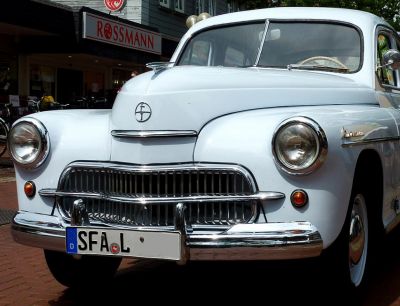 1946 GAZ 20 Dimensions, Size & Specs
1946 GAZ 20 Dimensions, Size & Specs
Measurements of the 1946 GAZ 20, engineered for optimal performance and comfort
| Dimensions | |
|---|---|
| Length: | 4665 mm183.7 in15.3 ft |
| Width: | 1695 mm66.7 in5.6 ft |
| Height: | 1640 mm64.6 in5.4 ft |
| Weight Specifications | |
| Curb Weight: | 1460 kg3219 lbs |
| Maximal permitted Weight: | 1835 kg4045 lbs |
| Tire Specifications | |
| Tire Size: |
|
The GAZ 20, produced by the Soviet manufacturer GAZ from 1946 to 1956, stands as a significant classic sedan representing post-World War II Soviet automotive engineering. This car generation was designed to provide reliable, durable transportation in a time of reconstruction and industrial growth. Measuring 4665 mm (183.7 inches) in length, 1695 mm (66.7 inches) in width, and 1640 mm (64.6 inches) in height, the GAZ 20 features balanced proportions typical of mid-20th-century sedans, offering notable interior space relative to its era.
With a curb weight of 1460 kg (3219 lbs) and a maximum weight capacity of 1835 kg (4046 lbs), this model was built with robust construction to handle varied road conditions common in the Soviet Union. The car rides on 205/75 R16 tires, which contribute to its stability and handling characteristics on different surfaces.
Overall, the GAZ 20 sedan embodies the practical and solid design philosophy of the late 1940s and early 1950s. It provides classic car enthusiasts and historians with a clear example of Soviet automotive priorities, emphasizing functionality and durability, while maintaining a respectable size and shape for family use and daily driving during its production period.
Discover the standout features that make the 1946 GAZ 20 a leader in its class
Have a question? Please check our knowledgebase first.
The GAZ 20 sedan, manufactured from 1946 to 1956, measures 4665 mm (183.7 inches) in length, 1695 mm (66.7 inches) in width, and 1640 mm (64.6 inches) in height. These dimensions place it comfortably within the size range of mid-20th century sedans. Its length offers ample cabin space, while its relatively moderate width and height help with urban maneuverability and parking.
The GAZ 20 has a curb weight of 1460 kg (approximately 3219 lbs). This is the weight of the vehicle including standard equipment, necessary operating consumables, and a full tank of fuel, but without passengers or cargo. The maximum weight that the car can safely carry—often called the gross vehicle weight—is 1835 kg (around 4046 lbs), which accounts for passengers and luggage in addition to the curb weight.
The GAZ 20 is equipped with tires sized 205/75 R16. These tires have a width of 205 mm, an aspect ratio of 75 (meaning the sidewall height is 75% of the tire's width), and fit on 16-inch rims. The relatively high sidewall profile contributes to a smoother ride by absorbing road imperfections, which suits the sedan's comfortable driving intent. Additionally, the tire size supports decent traction and load-bearing capacity for a vehicle of this weight.
Standard garages typically have a width of around 2.5 to 3 meters (8.2 to 9.8 feet), length around 5.0 to 6.0 meters (16.4 to 19.7 feet), and height over 2.1 meters (6.9 feet). With the GAZ 20 measuring 1695 mm (1.695 meters) wide and 4665 mm (4.665 meters) long, it comfortably fits inside a standard garage footprint. Its height of 1640 mm (1.64 meters) also leaves sufficient clearance under typical garage door heights. Therefore, parking the GAZ 20 in a standard garage should pose no problems.
The GAZ 20 was introduced after World War II and succeeded earlier models such as the GAZ M-1. Compared to its predecessor, the GAZ 20 is generally larger and more modernized. Its length of 4665 mm (183.7 inches) and width of 1695 mm (66.7 inches) represent a modest increase over earlier models, providing more interior space and passenger comfort. This uptick in size was part of a broader trend in automotive design post-war, accommodating heavier engines and enhanced features while improving road presence and safety.
In the context of late 1940s sedans, the GAZ 20's dimensions place it roughly in the mid-size category. For example, cars like the Ford Deluxe Sedans or Chevrolet Fleetline models of the era had lengths around 4600 to 4800 mm and widths near 1700 mm, comparable to the GAZ 20's 4665 mm length and 1695 mm width. Thus, the GAZ 20 aligned well with international standards of the time, offering a competitive cabin space and road presence within its class.
While exact interior dimensions for the GAZ 20 aren't commonly specified, its external length of 4665 mm and width of 1695 mm suggest that it offers reasonable passenger room typical of mid-size sedans from the 1940s. Seating arrangements generally allowed for five occupants comfortably (two in front and three in the rear bench seat). The vehicle's height of 1640 mm gives adequate headroom. The overall design emphasized spaciousness and comfort, characteristic of post-war sedans aimed at family or official use.
The GAZ 20 was most commonly powered by a 3.5-liter inline-four engine producing approximately 76 horsepower. Given the vehicle's curb weight of around 1460 kg, this powertrain offered adequate performance for everyday driving conditions of its time, focusing more on reliability and durability than high speed. The car featured rear-wheel drive with a 3-speed manual transmission, contributing to straightforward handling and maintainability, important for the post-war Soviet automotive market.
Despite being a vintage vehicle produced between 1946 and 1956, the GAZ 20's dimensions and moderate size make it fairly easy to drive and park in contemporary urban environments. Its 1695 mm width and 4665 mm length are modest compared to many modern sedans and SUVs. However, drivers should consider that its heavier weight (1460 kg) and older mechanical design mean braking, acceleration, and maneuverability may not meet modern standards. Nonetheless, for enthusiasts and collectors, the GAZ 20 remains manageable on typical roads and in standard parking spaces.
The GAZ 20 uses 205/75 R16 tires, which are somewhat unusual by today's passenger car standards, where smaller wheel diameters (14-15 inches) are more common. However, 16-inch tires are still widely available, and the 205 mm width with a high sidewall (75%) provides a comfortable ride and good load capacity for a vehicle weighing up to 1835 kg max. For classic car owners, sourcing these tires may require looking at specialty or vintage tire suppliers, but maintenance is straightforward due to the tire size compatibility with certain SUV or light truck tires currently in production.
Discover similar sized cars.

| Model Year: | 1946 |
|---|---|
| Length: | 4665 mm183.7 in |
| Width: | 1695 mm66.7 in |
| Height: | 1640 mm64.6 in |

| Production: | 1955-1958 |
|---|---|
| Model Year: | 1955 |
| Length: | 4665 mm183.7 in |
| Width: | 1695 mm66.7 in |
| Height: | 1640 mm64.6 in |
